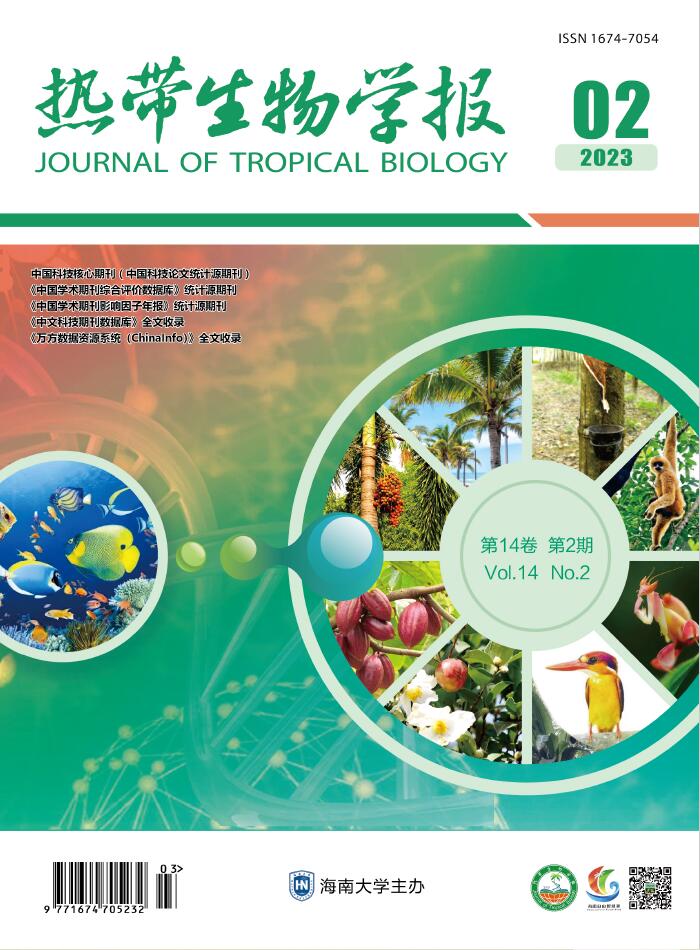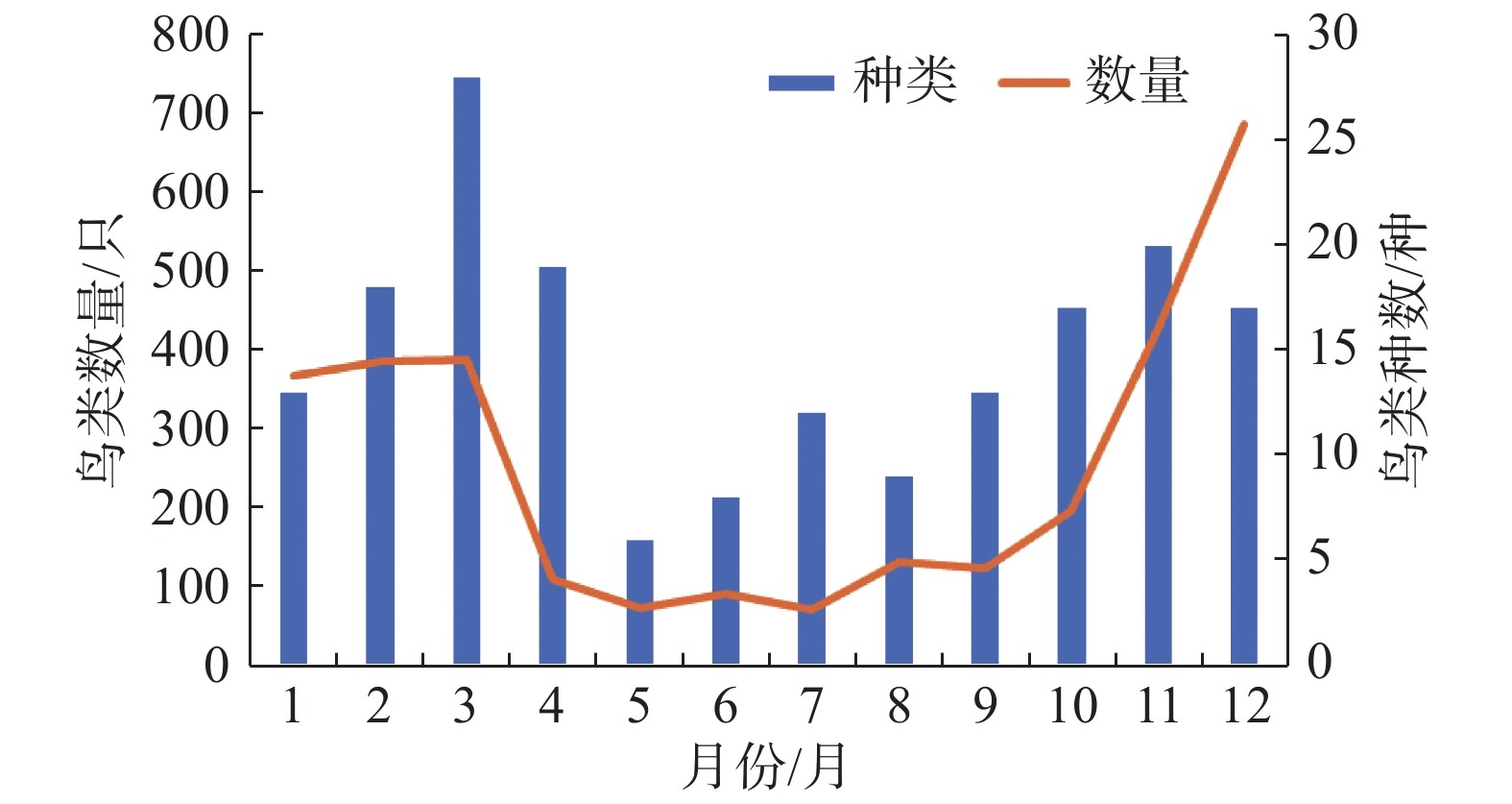-
生物多样性是人类赖以生存的基础,可以影响一个国家、地区乃至全球经济的发展和繁荣[1]。湿地作为一种独特的生态系统,具有多种功能和价值,是丰富自然界生物多样性、人类社会赖以生存和发展的环境之一[2]。由于湿地生态系统的特殊性和复杂性,使其极易发生变化[3-4]。湿地鸟类对生境变化非常敏感,是湿地生态系统的重要组成部分,其群落组成和种群数量是湿地监测和评价的重要指标之一[5],并在能量转换和维护生态的稳定方面起着重要的作用[6]。红树林是热带、亚热带海岸带的重要湿地类型[7],为红树林区底栖动物的生活提供了能量来源,丰富的底栖动物又为鸟类等高等动物提供了充足的食物来源[8]。新盈红树林国家湿地公园作为典型的红树林,湿地生态系统结构完整,生物多样性丰富[9-10]。然而,目前针对新盈红树林国家湿地公园的鸟类多样性研究较少,尤其是保护区内鸟类多样性调查鲜见报道,给保护区的生态系统评估带来了不便。因此,本研究通过采用样点和样线相结合的办法对海南新盈红树林国家湿地公园的鸟类多样性进行调查,旨在进一步了解新盈红树林的鸟类多样性和增加保护区鸟类生物多样性数据的连续性,为后续对保护区鸟类进行长时间监测评价提供数据支撑。
-
新盈红树林国家湿地公园坐落在海南省儋州市东北部后水湾内(19°51′48″~19°55′11″N,109°29′50″E),与临高县毗邻。园内的地理位置和独特地貌、高温高湿的气候特征和潮汐特征为红树林和与之相适应的野生动植物提供了多种生境,这也决定了保护区内具有丰富的自然景观、遗传、物种和生物系统多样性。
公园总面积507.05 hm2,地处热带与亚热带交界区,地理位置特殊,区间生物具有典型性、区位性和稀有性,保护价值高。公园内有丰富的植物种类,特别是红树林,面积达197.76 hm2,占保护区总面积的39%。主要种类有红海兰(Rhizophora stylosa)、木榄(Bruguiera gymnorhiza)、角果木(Ceriops tagal)、秋茄树(Kandelia candel)、海榄雌(Avicennia marina)等真红树8科15种,半红树5科5种。得益于保护区内良好的生态环境,每年这里都会吸引大批的候鸟前来越冬,其中,就包括属于国家Ⅰ级野生保护动物的勺嘴鹬(Calidris pygmaea)和黑脸琶鹭(Platalea minor)等珍稀濒危鸟类。
-
2016年1—12月,由国家林业局组织开展了新盈红树林国家湿地公园全国沿海水鸟同步调查工作,采用定点观察法和路线调查相结合的办法,对保护区内2016年度的鸟类多样性进行调查和研究。在研究区头、中、尾3个部位布设3个固定样点,基本覆盖整个保护区,每个点之间设立调查路线。沿线以2~3 km·h−1的速度匀速行走,借助双筒望远镜观察线路两侧,单筒望远镜记录样线两侧300 m的鸟类的种类、数量、行为和未识别鸟种,监测生境类型为退潮后红树林湿地滨海滩涂。根据海南气候特点,本文中春季为3—5月,夏季为6—8月,秋季为9—11月,冬季为12月至翌年2月。鸟类的濒危等级参考2021年公布的IUCN濒危物种红色名录、鸟类鉴定依据《中国鸟类野外手册》[11],鸟类居留型、分类及名录依据《中国鸟类分类与分布名录(第3版)》[12],鸟类保护级别则依据《国家重点保护野生动物名录(2021版)》[13]。
观测时间为全球环境基金(GEF)海南湿地保护体系项目组安排的统一监测时间,与全国沿海水鸟同步调查的时间一致,具体日期为:1月15日、2月12日、3月14日、4月20日、5月14日、6月18日、7月24日、8月22日、9月16日、10月23日、11月27日和12月15日。
-
物种多样性指标统计,采用Shannon-Wiener[14]指数进行计算:
式中:
$ H $ 为物种多样性指数,$ S $ 为物种数目(个),$ {P}_{i} $ 属于物种i的个体在全部个体种的比例(%)。$ H $ 值越大,鸟类群落多样性就越大;$ H $ 值越小,鸟类群落多样性就越小。物种均匀度指标统计,是在Shannon-Wiener指数基础上的Pielou均匀度指数[15]:
式中:
$ E $ 为均匀性指数,$ H $ 为物种多样性指数,$ {H}_{\mathrm{m}\mathrm{a}\mathrm{x}} $ 为多样性指数的最大值,$ S $ 为物种种类总数(个)。Simpson优势度指数:
式中:
$ C $ 为物种优势度指数,$ S $ 为物种数目(个),$ {P}_{i} $ 属于种i的个体在全部个体种的比例(%)。 -
本次调查共记录到鸟类3 148只,隶属7目19科57种(表1)。其中,鸻形目鸟类种数最多,共26种,占鸟类种数的45.61%;其次为雀形目,共12种,占鸟类种数的21.05%。从居留类型分析,留鸟18种,占鸟类种数的31.58%;冬候鸟23种,占40.35%;旅鸟有7种,占12.28%;夏候鸟1种,为黑枕黄鹂(Oriolus chinensis);迷鸟1种,为半蹼鹬(Asian dowitcher);旅鸟或冬候鸟有4种,为灰翅浮鸥(Chlidonias hybrida)、矶鹬(Actitishy poleucos)、灰尾漂鹬(Tringa brevipes)、红尾伯劳(Lanius cristatus),占7.02%;冬候鸟或留鸟2种,为牛背鹭(Bubulcus ibis)和池鹭(Ardeola bacchus),占3.51%。
物种 保护级别 居留型 鸟类数量/只 总计/只 春季 夏季 秋季 冬季 一、佛法僧目Coraciiformes (一)翠鸟科Alcedinidae 1.白胸翡翠Halcyon smyrnensis Ⅱ R 3 4 7 2.斑鱼狗Ceryle rudis R 1 1 1 3 3.普通翡翠Alcedo atthis R 2 1 1 4 4.蓝翡翠Halcyon pileata R 1 1 二、鹤形目Gruiformes (二)秧鸡科Rallidae 5.黑水鸡Gallinula chloropus R 2 2 6.灰胸秧鸡Gallirallus striatus R 1 1 三、鸻形目Charariiformes (三)鸻科Charadriidae 7.环颈鸻Charadrius alexandrinus W 40 9 49 8.蒙古沙鸻Charadrius mongolus P 104 16 237 39 396 9.铁嘴沙鸻Charadrius leschenaultii P 2 3 5 10.灰斑鸻Pluvialis squatarola W 2 7 8 3 20 11.金斑鸻Pluvialis fulva W 16 16 12.灰头麦鸡Vanellus cinereus W 1 1 (四)鸥科Laridae 13.红嘴鸥Larusridi bundus W 26 350 376 14. 灰翅浮鸥Chlidonias hybrida W,P 3 3 15.红嘴巨燕鸥Sterna caspia R 400 400 (五)鹬科Scolopacidae 16.白腰杓鹬Numenius arquata Ⅱ W 3 12 21 16 52 17.青脚鹬Tringane bularia W 36 26 40 54 156 18.中杓鹬Numenius phaeopus P 64 71 107 52 294 19.矶鹬Actitishy poleucos W,P 4 3 4 11 22 20.红脚鹬Tringa totanus W 33 12 60 132 237 21.泽鹬Tringa stagnatilis W 13 12 39 64 22.黑腹滨鹬Calidris alpina W 8 1 9 23.林鹬Tringa glareola W 12 6 7 25 24.翘嘴鹬Xenus cinereus P 1 8 9 25.弯嘴滨鹬Calidris ferruginea W 13 13 26.勺嘴鹬Calidris pygmaea Ⅰ W 1 1 27.红颈滨鹬Calidris ruficollis W 1 1 28.灰尾漂鹬Tringa brevipes W,P 1 1 29.流苏鹬Calidris pugnax W 1 1 30.斑尾塍鹬Limosa lapponica P 1 1 31.黑尾塍鹬Limosa limosa P 2 2 32.半蹼鹬Limnodromus semipalmatus Ⅱ V 1 1 四、鹃形目Cuculiformes (六)杜鹃科Cuculidae 33.八声杜鹃Cacomantis merulinus R 1 1 五、雀形目Passeriformes (七)伯劳科Laniidae 34.棕背伯劳Lanius schach R 3 3 35.红尾伯劳Lanius cristatus W,P 1 1 (八)鸫科Turdidae 36.乌鸫Turdus mandarinus R 1 1 (九)黄鹂科Oriolidae 37.黑枕黄鹂Oriolus chinensis S 1 1 (十)鹡鸰科Motacillidae 38.田鹨Anthus richardi W 4 4 39.红喉鹨Anthus cervinus W 5 5 40.黑卷尾Dicrurusm acrocercus R 5 5 (十一)扇尾莺科Cisticolidae 41.棕扇尾莺Cisticola juncidis W 8 8 (十二)鹟科Muscicapidae 42.鹊鸲Copsychus saularis R 3 3 6 (十三)绣眼鸟科Zosteropidae 43.暗绿绣眼Zosterops simplex W 8 8 (十四)燕科Hirundinidae 44. 家燕Hirundo rustica R 30 30 (十五)啄花鸟科(Dicaeidae) 45.朱背啄花鸟Dicaeum cruentatum R 3 3 六、鹈形目Pelecaniformes (十六)鹮科Threskiorothidae 46.黑脸琵鹭Platalea minor Ⅰ W 20 66 86 47.白琵鹭Eurasian Spoonbill Ⅱ W 1 1 (十七)鹭科Ardeidae 48.大白鹭Ardea alba R 52 44 60 87 243 49.白鹭Egretta garzetta R 102 87 154 136 479 50.绿鹭Butorides striata R 3 15 4 1 23 51.池鹭Ardeola bacchus R,W 8 2 4 2 16 52.苍鹭Ardea cinerea W 3 3 1 7 53.牛背鹭Bubulcus ibis R,W 38 38 54.中白鹭Ardea intermedia W 2 2 七、鹰形目Accipitriformes (十八)鹗科Pandionidae 55.鹗Pandion haliaetus Ⅱ R 1 1 (十九)鹰科Accipitridae 56.灰脸鵟鹰Butastur indicus P 1 1 57.白腹鹞Circus spilonotus Ⅱ W 2 2 注:Ⅰ为国家Ⅰ级重点保护野生动物,Ⅱ为国家Ⅱ级重点保护野生动物;R.留鸟,S.夏候鸟,W.冬候鸟,P.旅鸟,V.迷鸟。 -
根据鸟类的生态习性及形态特点,可将鸟类分为鸣禽、攀禽、陆禽、猛禽、涉禽和游禽6种不同的生态类型[12](表2)。新盈红树林国家湿地公园6种鸟类生态类型均涉及,按物种数量排序为涉禽>鸣禽>攀禽>游禽=猛禽>陆禽;按照观察记录数量排序为涉禽>游禽>鸣禽>攀禽>猛禽>陆禽。保护区内涉禽种类最丰富(57.89%),观察记录数量也最多(72.17%),而陆禽种类(1.75%)和记录数量(0.06%)都最少;猛禽种类和数量都较少(5.26%),低于国内猛禽分布平均水平(6.9%)[16]。
生态类型 种类/种 种类占比/% 数量/只 数量占比/% 游禽 3 5.26 779 24.75 涉禽 33 57.89 2272 72.17 猛禽 3 5.26 4 0.13 陆禽 1 1.75 2 0.06 攀禽 5 8.77 16 0.51 鸣禽 12 21.05 75 2.38 -
将数量占比超过5%的物种列为优势物种。从表3可知,春季优势种有8种,包括环颈鸻(Charadrius alexandrinus)、蒙古沙鸻(Charadrius mongolus)、青脚鹬(Tringane bularia)、中杓鹬(Numenius phaeopus)、红脚鹬(Tringa totanus)、大白鹭(Ardea alba)、白鹭(Egretta garzetta)、牛背鹭(Bubulcus ibis);夏季优势种有蒙古沙鸻、青脚鹬、中杓鹬、大白鹭、白鹭5种;秋季优势种包括蒙古沙鸻、青脚鹬、中杓鹬、大白鹭、红脚鹬、白鹭6种;冬季有红嘴鸥(Larusridi bundus)、红嘴巨燕鸥(Sterna caspia)、红脚鹬、大白鹭、白鹭5种优势种。保护区内2016年全年的优势种有7种,分别是蒙古沙鸻、红嘴鸥、红嘴巨燕鸥、中杓鹬、红脚鹬、大白鹭和白鹭,其中,大白鹭和白鹭2种鸟类是一年四季都属于优势种的鸟类。
春季 占比/% 夏季 占比/% 秋季 占比% 冬季 占比/% 全年 占比/% 蒙古沙鸻 16.86 白鹭 28.52 蒙古沙鸻 30.23 红嘴巨燕鸥 27.74 白鹭 15.22 白鹭 16.53 中杓鹬 23.28 白鹭 19.64 红嘴鸥 24.27 红嘴巨燕鸥 12.71 中杓鹬 10.37 大白鹭 14.43 中杓鹬 13.65 白鹭 9.43 蒙古沙鸻 12.58 大白鹭 8.43 青脚鹬 8.52 红脚鹬 7.65 红脚鹬 9.15 红嘴鸥 11.94 环颈鸻 6.48 蒙古沙鸻 5.25 大白鹭 7.65 大白鹭 6.03 中杓鹬 9.34 牛背鹭 6.16 青脚鹬 5.10 大白鹭 7.72 青脚鹬 5.83 红脚鹬 7.53 红脚鹬 5.35 -
此次列为特殊鸟种的鸟类包括IUCN(Ramirez2021)濒危的鸟种、《国家重点保护野生动物名录(2021版)》列为重点保护动物的鸟种和新盈红树林保护区内2016年新记录物种。
保护区内列入IUCN濒危物种红色名录近危(NT)的鸟类3种,分别是黑尾塍鹬、红颈滨鹬、弯嘴滨鹬;易危(VU)1种,为蓝翡翠;极危(CR)和濒危(EN)的鸟类各有1种,分别是勺嘴鹬和有黑脸琵鹭,同时这2种鸟类也被列为国家Ⅰ级重点保护野生动物。国家Ⅱ级重点保护野生动物有6种,为白胸翡翠、白腰杓鹬、鹗、半蹼鹬、白琵鹭、白腹鹞,国家重点保护野生动物占保护区内鸟类种数的14.04%,低于国家平均保护水平(15.6%)[2,12]。此外,此次调查首次在公园区内发现弯嘴滨鹬(13只)、灰脸鵟鹰(1只)、黑枕黄鹂(1只)3种鸟类,为2016年新盈红树林国家湿地公园鸟类新记录。
-
通过调查监测的结果来看,3月份水鸟种类最多,有28种,5月份则最少,只有6种。鸟类数量在1—3月、11月、12月最多,均超过300只;5—7月最少,数量少于100只(图1)。
本次调查从鸟类种类及数量上看,季节差异明显。春季共记录鸟类35种617只,隶属于6目13科,夏季共记录鸟类16种305只,隶属于5目7科,秋季共记录鸟类30种784只,隶属于5目9科,冬季共记录鸟类27种1442只,隶属于4目8科,4个季节均记录到的鸟类有11种,仅春季记录到的鸟类有24种,仅夏季记录到的鸟类有5种,仅秋季记录到的鸟类有19种,仅冬季记录到的鸟类有16种。春季鸟类种数、多样性指数、均匀度指数均高于其他3个季节,但优势度指数最低,为0.09;优势度指数夏季和秋季最高,其次为冬季,优势度指数为0.16;夏季鸟类种数、个体数、多样性指数均最低,但优势度指数高于春季和冬季见表4)。
季节 鸟类
种数/种鸟类
个体数/只多样性
指数均匀度
指数优势度
指数春季 35 617 2.70 0.76 0.09 夏季 16 305 2.07 0.75 0.17 秋季 30 784 2.22 0.65 0.17 冬季 27 1 442 2.21 0.67 0.16 -
公园内鸟类生物多样性在不同季节差异明显,在鸟类种类上,表现为春季>秋季>冬季>夏季,而在鸟类数量上,则表现为冬季>秋季>春季>夏季。分析其原因主要是保护区处于海南岛最北部,位于鸟类从东亚到澳大利西亚迁徙的线路上,是候鸟途径海南的第一站。从秋季开始,保护区鸟类种类开始增加,数量开始增多,而到冬季后,大部分候鸟在保护区内只是短暂的停留,在途径海南后继续向南飞行,因此在种类上没有达到最高,反而由于源源不断的候鸟迁徙,春季的物种数量达到峰值,而冬季有稳定的种群选择在海南越冬,则在数量上达到最多。在夏季,由于候鸟陆续离开海南岛,保护区内的鸟类种类、数量都降到全年的最低值。针对公园内鸟类生物多样性的变化情况,不同季节应采取不同的保护管理措施,建议在春季和冬季鸟类物种和数量丰富的季节增加鸟类调查监测的频率和保护力度,观测鸟类多样性变化情况来评价保护区环境状况。
由于国家对生态文明建设的高度重视,近年来加大了生态保护与修复力度,海南省政府更是大力推行退塘还湿政策,部分鱼塘被重新改化为红树林湿地,新盈红树林国家湿地公园生态系统得到较好的提升。此次调查首次在保护区内发现弯嘴滨鹬、灰脸鵟鹰、黑枕黄鹂,为2016年新盈红树林湿地公园鸟类新记录,而且还有国家重点保护动物8种,包括勺嘴鹬、黑脸琵鹭2种国家Ⅰ级保护动物。不过,保护区内国家重点保护鸟类还是低于国家平均保护水平,猛禽种类和数量也低于国内猛禽分布平均水平,这也说明,保护区内物种多样性还不够丰富,食物链顶级类群还比较缺乏,生态系统健康水平还有待进一步提高,在以后的工作中还需加大监测力度,完善鸟类监测及巡护体系,采用红外相机和无人机等新型装备对公园内监测薄弱区和人为干扰区进行重点监测。
Avian diversity at Hainan Xinying mangrove national wetland park
DOI: 10.15886/j.cnki.rdswxb.2023.02.008
- Received Date: 2022-07-21
- Accepted Date: 2022-11-29
- Rev Recd Date: 2022-11-27
- Available Online: 2023-03-26
- Publish Date: 2023-03-25
-
Key words:
- bird diversity /
- bird survey /
- Xinying mangrove forest /
- wetland park
Abstract: In order to have a basic picture of the birds at Hainan Xinying Mangrove National Wetland Park in Danzhou, Hainan, a combination of point counts and line transects was used to estimate the bird diversity at Hainan Xinying Mangrove National Wetland Park from January to December 2016, and a total of 57 species of birds in 7 orders and 19 families were recorded. Among them three species were recorded as Near Threatened (NT) on the IUCN Red List of Threatened Species, namely black-tailed sandpiper (Limosa limosa), red-necked sandpiper (Calidris ruficollis) and the bent-billed sandpiper (Calidris ferruginea); one species was recorded as Vulnerable (VU), blue jade (Halcyon pileata); one species of Critically Endangered (CR) and one species of Endangered (EN) birds, namely spoonbill sandpiper (Calidris pygmaea) and black-faced spoonbill (Platalea minor), respectively, which are also listed as wild animals in Class I under state protection. There are six species of wildlife at Class II under state protection, namely white-breasted emerald (Halcyon smyrnensis), Eurasian curlew (Numeniu sarquata), Osprey (Pandion haliaetus), semipalmated sandpiper (Limnodromus semipalmatus), Eurasian spoonbill (Platalea leucorodia), and white-bellied harrier (Circus spilonotus). The number of birds tended to be in the order of winter > autumn > spring > summer, and the number of bird species was in the order of spring > autumn > winter > summer. Birds were highest in number in January-March, November and December with over 300 birds, and lowest in May-July with less than 100 birds. The number of bird species (35), diversity index (2.7) and evenness index (0.76) were higher in spring than in the other three seasons, while the highest dominance index was in summer (0.17) and autumn (0.17). The survey found three species of birds for the first time at the park: the bent-billed shorebird (C. ferruginea), the grey-faced buzzard (Butastur indicus) and the black-cushioned oriole (Oriolus chinensis), which are new records of birds at the Hainan Xinying Mangrove National Wetland Park, but in general, the proportion of birds under state protection at the park is lower than the national average, and the species and number of raptors are also lower than the average of raptors distributed in China, indicating that the protected area is not rich enough in species diversity and that the top taxa of the food chain are still lacking. This survey provides some data for the next long-term monitoring and evaluation of birds at the park, and the reasons for changes in the global migration of birds throughout the year were analyzed, based on which targeted conservation recommendations are proposed.
| Citation: | ZHANG Xiaohai, LUO Lixiang, CHEN Zeheng, LU Gang, HUANG Fulin, LI Fangyi, ZHAI Ruihao. Avian diversity at Hainan Xinying mangrove national wetland park[J]. Journal of Tropical Biology, 2023, 14(2): 189-195. doi: 10.15886/j.cnki.rdswxb.2023.02.008 |




















 DownLoad:
DownLoad: